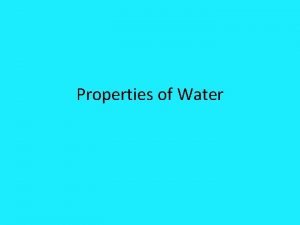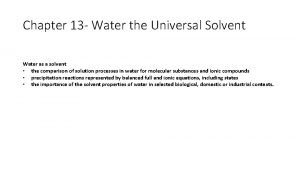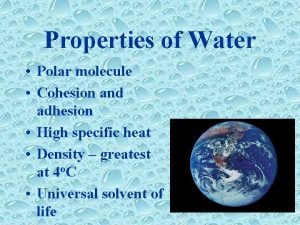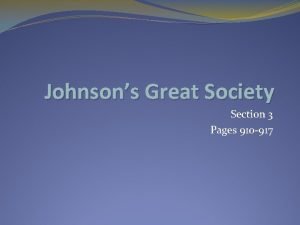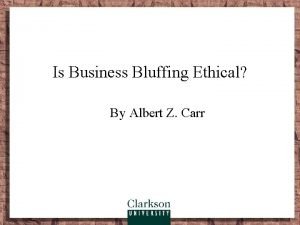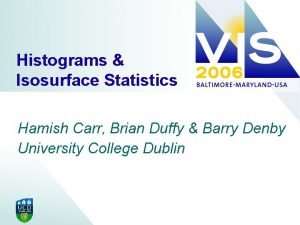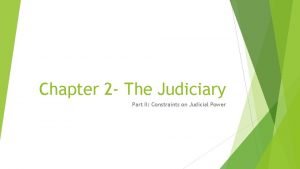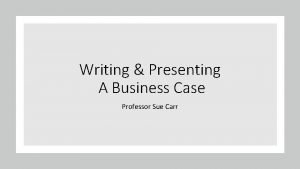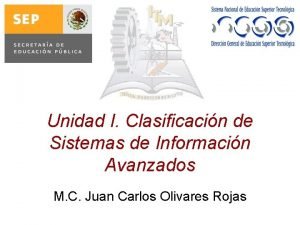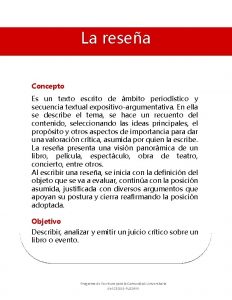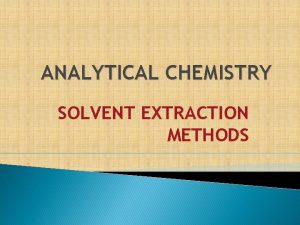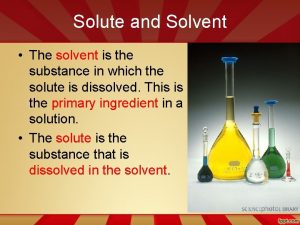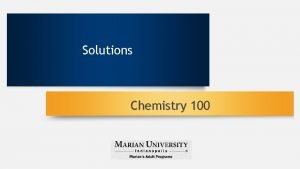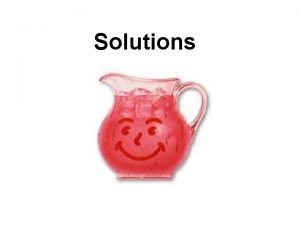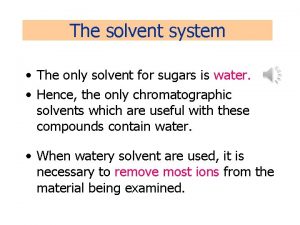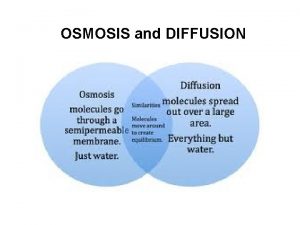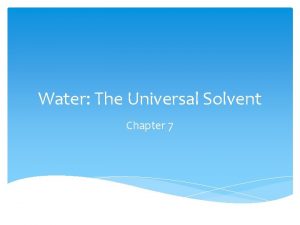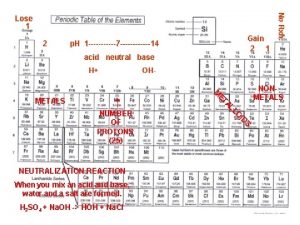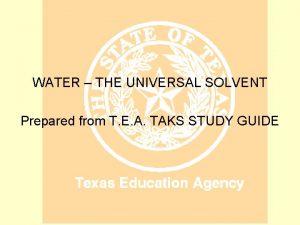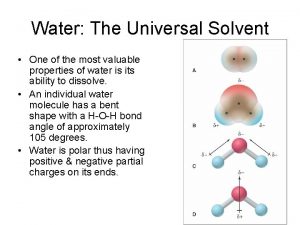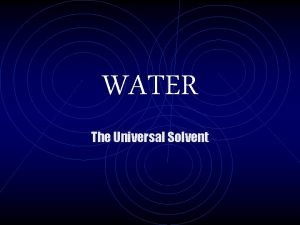The Universal Solvent Carr Chapter 5 Richard T

























- Slides: 25

The Universal Solvent Carr, Chapter 5 Richard T. Christoph INFS 780

Technical advances often destroy n Railroad eliminated locational advantages firms had n Suddenly, it was easy to ship goods over long distance n Telephone halted advantages of long-term relationships n I could talk about products anywhere n IT is doing the same n Consider on-line investing

Carr notes (pg 88): n IT can corrode advantages not just in one or a few areas, but across many aspects of a company’s business. n Traditional advantages tend to dissipate as the function is automated n Is this right?

Software impact n Automated systems in customer service (or other areas) removes differences in response times All players in the industry will have about the same response parameters n Not possible to achieve distinction when using the same software n n This is great if this function is not your basis for advantage

Homogenization n Functions become the same from firm to firm n The Internet has dramatically increased this impact Advantages based in proprietary networks are gone n Carr suggests the Internet has pushed power away from firms and into customers n

Compare catalog order vs. Internet n The catalog places premium on n n Catalog size, quality n Allows my store to differentiate Cost of distribution is high, n mailing list management critically important n Internet n Focus on speed n Customer can “drop” my store for another n Cheap distribution costs n All internet sites look alike – no advantage for size

Porter’s Comments on the Internet n Internet provides easy access for buyers to information n n Traditional Sales force not as critical n n Reduces barriers to entry Proprietary systems decrease n n Buyer power rises Rivalry increases The main benefits from the Internet (access, information) reduce the transaction costs and profitability to many firms

Competitive Advantage n Sustainable advantage n Firm can build a long-term advantage over peers n IT likely will not do this today n Leverageable Advantage n A fleeting advantage that will be quickly copied by competitors n IT can certainly provide this – but not for long

Value Innovation n Why do firms exist? n Economists state that markets are the most efficient way to distribute goods n n Think of commodities markets for oil, wheat, corn, etc. If this is true, why create a firm to distribute goods in place of a market? n Firms must add expense over a plain market!

Why do firms exist? n Remember Ronald Coase? He suggested that transaction costs were the reason firms are created. n Transaction costs are all costs buyer and seller incur as they gather information and negotiate a sale. n n These quickly add up Consider trying to buy a car – what do you have to do?

Transaction costs n Costs are higher when the product is complex and varied; conversely, costs are lower when the product is a commodity n n Corn futures markets work well since there are low transaction costs Home sales have high transaction costs, so firms (Realtors) have developed n When firms are created, functions are “aggregated” together

What about technology? n How has technology changed transaction cost over time? More information is quickly available n This lowers transaction costs n Reduces need for the middle firm n n Some argue that firms will disappear and all of us become contractors n Technology allows dis-aggregation

Disaggregation Trends n What does this mean? n Why do it? n Is this not the exact opposite of vertical/horizontal integration? Which is right? n How do transaction costs enter in this?

Transaction Costs could Cause larger firms n Carr notes that as IT lower transaction costs, vertical integration could increase leading to larger and larger firms n This is normal in maturing markets Lower transaction costs allow easier management n Consider Wal. Mart n

Bottom line n Do not confuse the business with the Information system n As information becomes easily available, it become less costly and possibly worth less (since all have about the same information) n Consider ERP systems

ERP & Strategy From Peoplesoft: Managing ERP Applications for Strategic Advantage �� “Improved Cost-Effectiveness. Proactive management and support means that problems are prevented before they decrease ROI. customers report lower maintenance and operating costs, often with a savings of 20 percent or more” Would Drucker say this focuses on effectiveness or efficiency?

ERP & Strategy From Peoplesoft: Managing ERP Applications for Strategic Advantage �� “Increased Efficiency. A first-call resolution up to 50 percent for user functionality questions increases the productivity of customers, freeing them to focus on managing and aligning workforce with corporate needs and increasing employee, partner, and customer satisfaction. ” Does Porter note this type of saving as a strategic one?

ERP & Strategy From Peoplesoft: Managing ERP Applications for Strategic Advantage �� “Expanded Strategic Focus. With all of the routine and mundane tasks covered, clients have the greater ability to leverage new capabilities within their ERP systems, like self-service functions for managers and employees” Would Carr state that these “strategic” benefits are able to build a proprietary competitive advantage?

What do these mean? n I suggest that these are really efficiency based n n This means such benefits, while valuable, are NOT strategic Could these sorts of benefits be infrastructural in nature? n Consider the electricity grid or highway system n Could we not point to similar benefits? If so, they are certainly NOT strategic.

IT examples n Carr notes that ERP systems allow all firms to be equally efficient Eliminates the efficient firm advantage n Best practices become universal practices n n What does this mean? n How do we compete now Is strategy dead? n What does this mean for IT? n

My Conclusions n ERP systems will tend to increase rivalry since all firms become more efficient n No longer can an unusually effective IT Dept. provide unique apps the yield competitive advantage n n Many ERP customization is done by 3 rd parties – available to all firms Customer clearly wins – but firm’s profit will probably not increase

My Conclusions n ERP may remove IT as a source of competitive advantage for a single firm ERP enforces discipline – you must do it their way. IT groups focus on the install of the ERP n ERP systems are so big that they tend to use all available IT resource n n After ERP install, what is the difference between Firm 1’s and firm 2’s information capability?

My Conclusions n Differentiation will be harder to achieve since more firms can do it. If ERP allows firms to customize marketing (or any other aspect of business) it is logical that more firms will try to do it. n Thus, differentiated marketing will become the norm n n Consider “Web-based marketing” – everyone now does it. How can you build a sustainable advantage on that?

My Conclusions n ERP systems are infrastructural Given the prior issues, I believe that ERP systems are becoming an infrastructural technology. n This means that all firms need it to compete at all n n n Similar to electricity, telephone, cash registers, etc If this is true, it means a fundamental change in the IT profession.

IT Changes n I submit that IT will change and that successful IT pros must: Focus increasingly on the business side – not the technology side n Carefully build accurate cost justification models n Assume that basic IT issues will be outsourced n Find the IT components that may have strategic value and build a business case there. n
 Chapter 7 water the universal solvent
Chapter 7 water the universal solvent Water is universal solvent
Water is universal solvent Water is universal solvent
Water is universal solvent What is a polar molecule
What is a polar molecule King richard iii and looking for richard
King richard iii and looking for richard Erika carr
Erika carr Indice de carr y hausner
Indice de carr y hausner Baker v carr ruling
Baker v carr ruling Albert carr theory
Albert carr theory Hamish carr
Hamish carr Baker vs carr summary
Baker vs carr summary Saxaglitin
Saxaglitin Baker vs carr summary
Baker vs carr summary Reagen carr price
Reagen carr price Simon thomas carr college
Simon thomas carr college Kirsten carr
Kirsten carr Emily carr high school
Emily carr high school Emily carr scorned as timber
Emily carr scorned as timber Bernard carr
Bernard carr Ecss school
Ecss school Carlo carr
Carlo carr Allen carr seminar wien
Allen carr seminar wien Dr sue carr
Dr sue carr Nicholas carr
Nicholas carr Nicholas carr
Nicholas carr Estruturalismo e funcionalismo
Estruturalismo e funcionalismo

